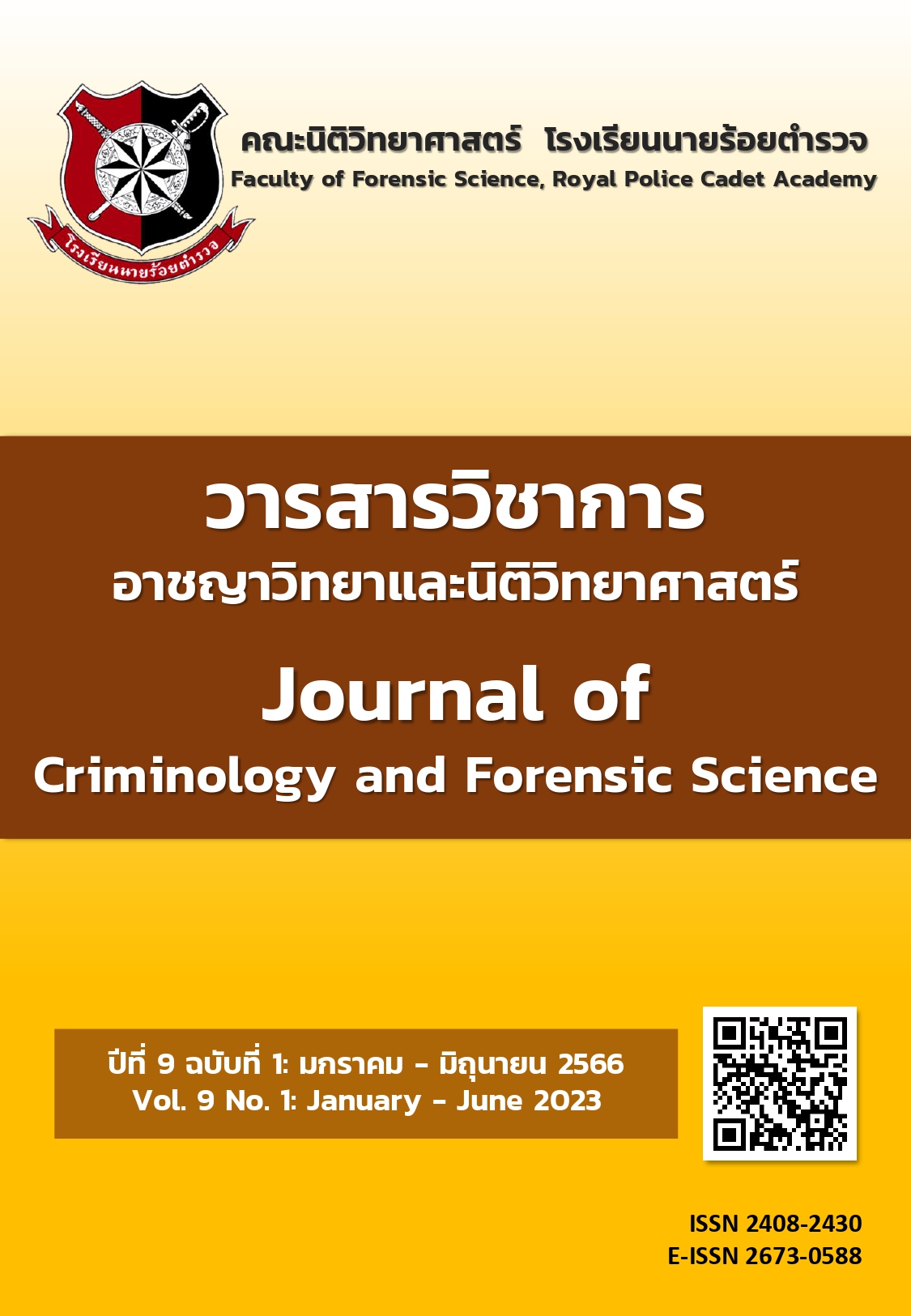ความสัมพันธ์ของการ์ตูนญี่ปุ่นแนวสืบสวนสอบสวนกับหลักการทางนิติวิทยาศาสตร์
Main Article Content
บทคัดย่อ
การ์ตูนญี่ปุ่นแนวสืบสวนสอบสวนเป็นสื่อที่นำหลักการทางนิติวิทยาศาสตร์มาประยุกต์ใช้ให้การสืบสวนสอบสวนในเรื่องมีความสมจริงและน่าเชื่อถือจนได้รับความนิยมอย่างแพร่หลาย แต่การอ้างถึงหลักการทางนิติวิทยาศาสตร์ของสื่อได้ก่อให้เกิดผลกระทบหลายด้าน เช่น ด้านงานยุติธรรม ด้านการก่ออาชญากรรมเลียนแบบ การวิจัยนี้จึงมีวัตถุประสงค์เพื่อศึกษาและวิเคราะห์หลักการทางนิติวิทยาศาสตร์ที่ปรากฏในสื่อว่ามีความสอดคล้องกับทฤษฎีหรือไม่ อย่างไร โดยใช้ระเบียบวิธีการวิจัยเชิงคุณภาพ ได้แก่ การวิจัยเอกสารและการสัมภาษณ์เชิงลึก โดยเลือกศึกษาในหนังสือการ์ตูนญี่ปุ่นเรื่อง ยอดนักสืบจิ๋ว โคนัน จำนวน 100 เล่ม ด้วยวิธีการเก็บข้อมูลบทสนทนาที่อ้างถึงหลักการทางนิติวิทยาศาสตร์ใน 3 กลุ่มเนื้อหา ได้แก่ การพิสูจน์หลักฐาน การตรวจสถานที่เกิดเหตุ และนิติเวชศาสตร์ นำมาจัดกลุ่มและเรียบเรียงเป็นหลักการเพื่อเปรียบเทียบกับทฤษฎีที่เกี่ยวข้อง รวมถึงใช้เป็นประเด็นคำถามในการสัมภาษณ์เชิงลึกจากผู้ให้ข้อมูลหลักซึ่งมีความเชี่ยวชาญด้านนิติวิทยาศาสตร์จำนวน 6 คน จากนั้นนำข้อมูลที่ได้มาวิเคราะห์เนื้อหาเพื่อทราบถึงความสัมพันธ์ ผลการศึกษาพบว่ามีบทสนทนาที่เข้าเกณฑ์การเลือก 235 บทสนทนา เรียบเรียงเป็นหลักการได้ 155 หลักการ มีความสอดคล้องกับหลักการทางนิติวิทยาศาสตร์ 80 หลักการ คิดเป็นร้อยละ 51.61 ไม่สอดคล้อง 12 หลักการ คิดเป็นร้อยละ 7.74 และสอดคล้องบางส่วน 63 หลักการ คิดเป็นร้อยละ 40.65 จึงสรุปได้ว่าหลักการทางนิติวิทยาศาสตร์ในยอดนักสืบจิ๋ว โคนันไม่ได้สอดคล้องกับทฤษฎีทั้งหมด โดยหลักการที่สอดคล้องสามารถอ้างอิงหรือนำไปใช้ได้ในทางปฏิบัติ ส่วนหลักการที่ไม่สอดคล้องและสอดคล้องบางส่วน เกิดจากปัจจัยต่าง ๆ ได้แก่ การแปลภาษา ตำราหรืองานวิจัยที่ผู้ประพันธ์ใช้อ้างอิง การปรับหลักการเพื่อให้เกิดความสะดวกต่อการประพันธ์เรื่อง และการปฏิบัติงานด้านนิติวิทยาศาสตร์ที่แตกต่างกันของแต่ละประเทศ ดังนั้นผู้อ่านจึงควรใช้วิจารณญาณในการรับข้อมูลด้านนิติวิทยาศาสตร์จากยอดนักสืบจิ๋ว โคนัน
Article Details

อนุญาตภายใต้เงื่อนไข Creative Commons Attribution-NonCommercial-NoDerivatives 4.0 International License.
เนื้อหาและข้อมูลในบทความที่ลงตีพิมพ์ใน วารสารวิชาการอาชญาวิทยาและนิติวิทยาศาสตร์ โรงเรียนนายร้อยตำรวจ ถิอว่าเป็นข้อคิดเห็นและความรั้บผิดชอบของผู้เขียนบทความโดยตรงซึ่งกองบรรณาธิการวารสาร ไม่จำเป็นต้องเห็นด้วยหรือรับผิดชอบใดๆ
บทความ ข้อมูล เนื้อหา รูปภาพ ฯลฯ ที่ได้รับการตีพิมพ์ใน วารสารวิชาการอาชญาวิทยาและนิติวิทยาศาสตร์ ถือว่าเป็นลิขสิทธิ์ของวารสาร วารสารวิชาการอาชญาวิทยาและนิติวิทยาศาสตร์ หากบุคคลหรือหน่วยงานใดต้องการนำทั้งหมดหรือส่วนหนึ่งส่วนใดไปเผยแพร่ต่อหรือเพื่อกระทำการใดๆ จะต้องได้รับอนุญาตเป็นลายลักษณ์อักษรจาก วารสารวิชาการอาชญาวิทยาและนิติวิทยาศาสตร์ ก่อนเท่านั้น
เอกสารอ้างอิง
Anime-Planet. (2023). Detective Conan. Retrieved April 15, 2023. from https://www.anime-planet.com/anime/detective-conan.
Aoyama, G. (1996). Detective Conan Volume 10. 1st Edition. Bangkok: Vibulkij. (In Thai).
Armstrong, K. (2018). The most common forensic science misconceptions. Retrieved August 24, 2022. from https://www.camdenadvertiser.com.au/story/3069684/the-most-common-forensic-science-misconceptions.
Baranowski, M., Burkhardt, A., Czernik, E. & Hecht, H. (2018). The CSI-education effect: Do potential criminals benefit from forensic TV series?. International Journal of Law, Crime and Justice, 52, 86–97.
Baskin, D. R., & Sommers, I. B. (2010). Crime-show-viewing habits and publicattitudes toward forensic evidence: The “CSI effect” revisited. Justice System Journal, 31, 97-113.
Chamasuwanwong, A. (2003). Forensic Science 1-3 for Investigation. 3th Edition. Bangkok: T.C.G.Printing. (In Thai).
Chaosincharoen, P. (2015). A Study of Language, Writing Techniques and the Contents of the Detective Conan, Japanese Comic Book Series, Thai Version. Humanities Journal (Graduate School), Ramkhamhaeng University, 4(1), 102-110. (In Thai).
Detective Conan World. (2023). Detective Conan. Retrieved April 15, 2023. from https://www.detectiveconanworld.com/wiki.
Huey, L. (2010). I’ve seen this on CSI: Criminal investigators’ perceptions about the management of public expectations in the field. Crime, Media, Culture, 6, 49-68.
Hughes, A. (2020). Assessment of PECA reagent on the development of fingerprints on fabrics. Master of Forensic Science theses, Murdoch University, Murdoch.
Lidman, M. (2012). Prosecution grills Daniel Maoz in murder trial. The Jerusalem Post. Retrieved April 9, 2023. from http://www.jpost.com/NationalNews/Article.aspx?id=270201.
Longtunman. (2018). What is the income of Detective Conan. Retrieved April 9, 2023. from https://www.longtunman.com/10498. (In Thai).
Mangazenkan. (2023). All-time circulation ranking. Retrieved April 9, 2023. from http:// www.mangazenkan.com/ranking/books-circulation.html. (In Japanese).
Park, D. (2010). Scary teenagers, after assaulting a friend for 3 days, abandoning the body and leaving traces of liver infection. Retrieved August 15, 2020. from http://www.todaykorea.co.kr/news/articleView.html?idxno=114057. (In Korean).
Saenkaew, K. (2019). The Study on Knowledge and Understanding of Crime Scene Investigation of Police Enquiry Officers in Nakhon Pathom Province. Journal of Research and Development Buriram Rajabhat University, 14(2), 121-136. (In Thai).
Soontherotoke, S. (2001). Forensic Science in the Detective Novels Ka-hon-ma-ho-ra-tuek and the Da Vinci Code. Manutsayasart Wichakan, 28(2), 161-189. (In Thai).
Sungkatip, P. (2014). Conan : The Murderer, Reasons and Finding Out The Truth. Retrieved April 11, 2023. from http://isas.arts.su.ac.th/?p=1465. (In Thai).
Symon, V., Heydon, S., Medlicott, N., Kieser, J. & Fleming, J. (2015). Before CSI: Making the Case for a Novel Portrayal of Forensic Science. The International Journal of Science in Society, 6(3-4), 7-15.
Vicary, A. & Zaikman, Y. (2017). The CSI Effect: An Investigation into the Relationship between Watching Crime Shows and Forensic Knowledge. North American Journal of Psychology, 19(1), 51-64.
Wise, J. (2010). Providing the CSI treatment: Criminal justice practitioners and the CSI effect. Current Issues in Criminal Justice, 21, 383-400.
Woharndee, P. (2019). A study of a relationship between injuries and pathological findings of the necks and hanging positions, ligature materials and other features. Research Report, Central Institute of Forensic Science. (In Thai).


